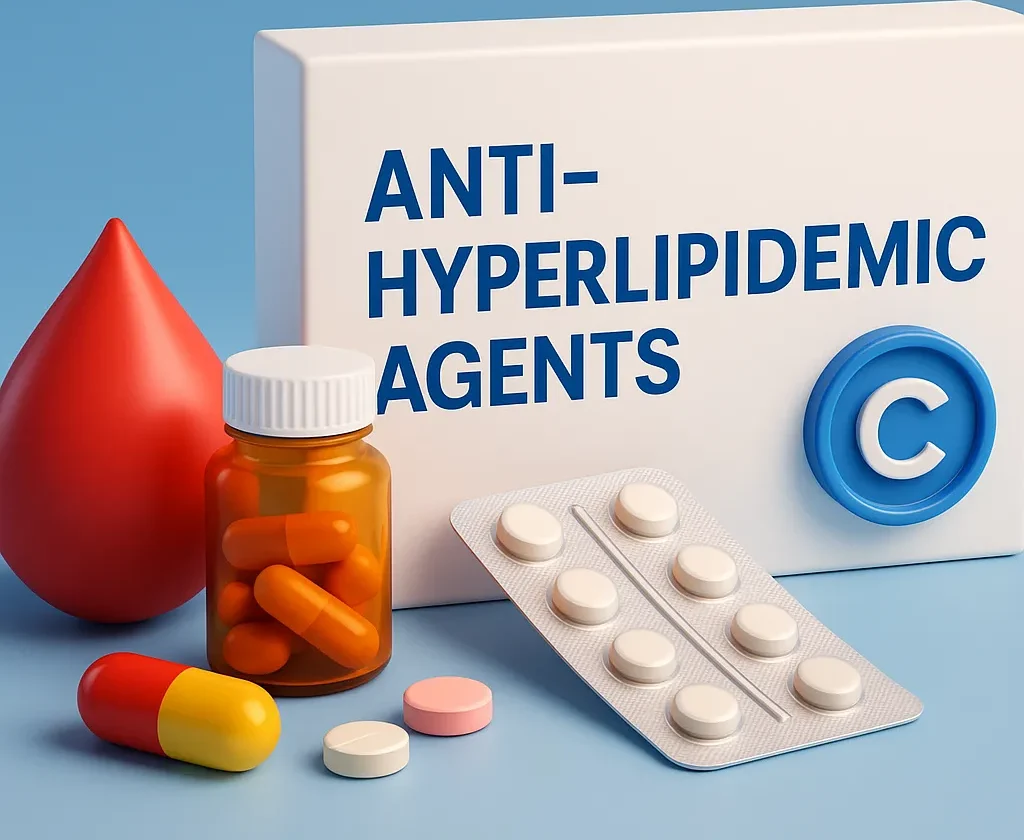Anti-hyperlipidemic agents lower blood lipid levels to prevent cardiovascular diseases like heart attack and atherosclerosis.
- Anti-hyperlipidemic agents are medications designed to manage abnormal lipid levels in the blood, thereby reducing the risk of atherosclerosis, coronary artery disease, and related cardiovascular events.
Pathophysiology of Hyperlipidemia
- Hyperlipidemia involves elevated levels of lipids (cholesterol and triglycerides) in the blood, which can lead to the formation of fatty deposits (plaques) in arteries.
- This process narrows and hardens arteries (atherosclerosis), increasing the risk of heart attacks, strokes, and peripheral vascular disease.
Classification of Anti-Hyperlipidemic Agents
- Anti-hyperlipidemic drugs are classified based on their primary mechanism of action:
Advertisements

-
Fibrates
- Mechanism of Action:
- Fibrates activate peroxisome proliferator-activated receptors (PPAR-α), leading to increased oxidation of fatty acids in the liver and muscle. This results in decreased triglyceride levels and, to a lesser extent, increased high-density lipoprotein (HDL) cholesterol.
- Common Drugs:
- Uses:
- Primarily used to reduce triglyceride levels.
- Can also modestly increase HDL cholesterol.
- Side Effects:
- Gastrointestinal disturbances (e.g., abdominal pain, nausea).
- Increased risk of gallstones.
- Myopathy, especially when combined with statins.
- Mechanism of Action:
-
Statins
- Mechanism of Action:
- Statins inhibit HMG-CoA reductase, the key enzyme in cholesterol synthesis in the liver. This leads to decreased low-density lipoprotein (LDL) cholesterol levels and upregulation of LDL receptors, enhancing clearance of LDL from the bloodstream.
- Common Drugs:
- Uses:
- Lowering LDL cholesterol.
- Reducing the risk of cardiovascular events (e.g., myocardial infarction, stroke).
- Stabilizing atherosclerotic plaques.
- Side Effects:
- Mechanism of Action:
-
Bile Acid Sequestrants
- Mechanism of Action:
- These agents bind bile acids in the intestine, preventing their reabsorption. The liver responds by converting more cholesterol into bile acids, thereby lowering circulating cholesterol levels.
- Common Drugs:
- Uses:
- Lowering LDL cholesterol.
- Reducing triglyceride levels.
- Increasing HDL cholesterol (to a minor extent).
- Side Effects:
- Gastrointestinal disturbances (e.g., constipation, bloating).
- Interference with the absorption of fat-soluble vitamins (A, D, E, K).
- May bind other medications, reducing their efficacy.
- Mechanism of Action:
| Class | Mechanism of Action | Common Drugs | Uses | Side Effects |
| Fibrates | Activates PPAR-α, increasing fatty acid oxidation, decreases triglycerides, modestly raises HDL | Clofibrate | Lowers triglycerides, slightly increases HDL | GI disturbances, increased gallstones, risk of myopathy with statins |
| Statins | Inhibits HMG-CoA reductase, decreases LDL cholesterol, increases LDL receptor activity | Lovastatin | Lowers LDL, reduces cardiovascular risks, stabilizes plaques | Myalgia, elevated liver enzymes, increased diabetes risk, GI issues |
| Bile Acid Sequestrants | Binds bile acids in intestine, prevents reabsorption, liver converts cholesterol to bile acids | Cholestyramine, Colestipol | Lowers LDL, reduces triglycerides, minor HDL increase | GI disturbances, affects fat-soluble vitamin absorption, may bind other medications |

